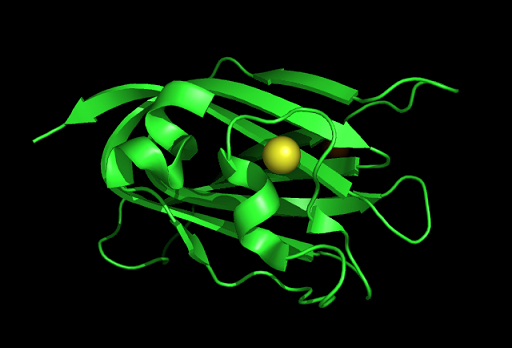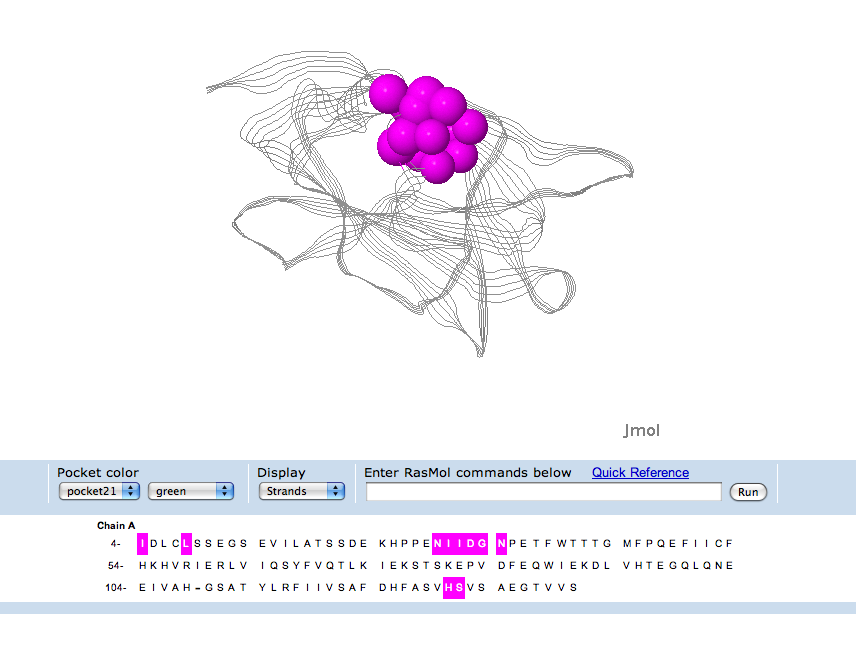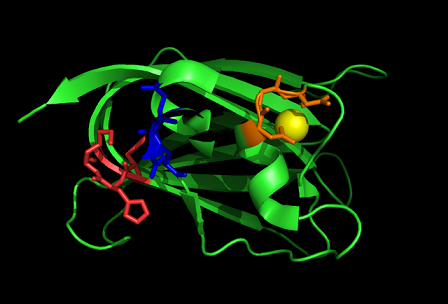Chromosome 1 open reading frame 41 Structure: Difference between revisions
Hana Hamzah (talk | contribs) No edit summary |
Hana Hamzah (talk | contribs) No edit summary |
||
| Line 15: | Line 15: | ||
'''Structure analysis''' | '''Structure analysis''' | ||
1)Structure similarities | '''1)Structure similarities''' | ||
DALI was used to find protein that are similar in structure to 1TVG. The results showed that sialidases, alpha-N-acetylglucosaminidases and galactose oxidases have similar structure to our protein as presented below. | DALI was used to find protein that are similar in structure to 1TVG. The results showed that sialidases, alpha-N-acetylglucosaminidases and galactose oxidases have similar structure to our protein as presented below. | ||
| Line 21: | Line 21: | ||
[[Image:Picture 1.png]] | [[Image:Picture 1.png]] | ||
2)Domain Classification | '''2)Domain Classification''' | ||
Pfam result indicated that our protein has a F5/8 type C domain, also known as the discoidin domain which is apart of galactose binding domain super family. | Pfam result indicated that our protein has a F5/8 type C domain, also known as the discoidin domain which is apart of galactose binding domain super family. | ||
| Line 29: | Line 29: | ||
Closer inspection of the other proteins from the DALI result showed that they also have discoidin domain in their structures. | Closer inspection of the other proteins from the DALI result showed that they also have discoidin domain in their structures. | ||
3)Possible ligand binding sites | '''3)Possible ligand binding sites''' | ||
Observations and comparisons of several proteins from the DALI result with our protein, there is a similar position on each proteins where a metal ion is located. | Observations and comparisons of several proteins from the DALI result with our protein, there is a similar position on each proteins where a metal ion is located. | ||
[[Image:1tvg ligand1.png]] | [[Image:1tvg ligand1.png]] | ||
| Line 40: | Line 41: | ||
Shown is the discoidin domain of galactose oxidase and a sodium ion (purple). | Shown is the discoidin domain of galactose oxidase and a sodium ion (purple). | ||
[[Image:2bzd discoidin2.png]] | [[Image:2bzd discoidin2.png]] | ||
| Line 48: | Line 50: | ||
[[Image:1tvg castp2.png]] | [[Image:1tvg castp2.png]] | ||
Below is a possible metal binding position on c1orf41. Orange is the residues that may be involved in coordinating the metal and blue is the calcium ion. | Below is a possible metal binding position on c1orf41. Orange is the residues that may be involved in coordinating the metal and blue is the calcium ion. | ||
[[Image:1tvg residue metal.png]] | [[Image:1tvg residue metal.png]] | ||
Nest analysis by Profunc suggested two other ligand binding sites. | Nest analysis by Profunc suggested two other ligand binding sites. | ||
| Line 57: | Line 61: | ||
[[Image:Nest analysis result.PNG]] | [[Image:Nest analysis result.PNG]] | ||
The locations of the binding sites are shown below. | The locations of the binding sites are shown below. CastP also predicted surface clefts similar to the erea of the nests. | ||
[[Image:1tvg nests.png]] | [[Image:1tvg nests.png]] | ||
Revision as of 08:07, 9 June 2009
Protein Structure
PDB ID: 1TVG Information from the PDB stated that x-ray diffraction was sued to solve the structure of this protein with an R value of 0.215 and at 1.6Å. Two ligands were present in the crystal structure, a calcium (II) ion and a samarium (III) ion. This protein has 153 residues and its secondary structure consists of two helices and nine beta sheet strands.
Above is the representation of 1TVG secondary structure using PDBsum.
This protein is monomeric and the connectivities between the secondary structures are shown below.
Structure analysis
1)Structure similarities
DALI was used to find protein that are similar in structure to 1TVG. The results showed that sialidases, alpha-N-acetylglucosaminidases and galactose oxidases have similar structure to our protein as presented below.
2)Domain Classification
Pfam result indicated that our protein has a F5/8 type C domain, also known as the discoidin domain which is apart of galactose binding domain super family.
Closer inspection of the other proteins from the DALI result showed that they also have discoidin domain in their structures.
3)Possible ligand binding sites
Observations and comparisons of several proteins from the DALI result with our protein, there is a similar position on each proteins where a metal ion is located.
This figure shows the position where calcium (II) ion (yellow) is located in within our protein structure. This loop structure was also observed in several top proteins in the DALI result.
Shown is the discoidin domain of galactose oxidase and a sodium ion (purple).
Shown is the discoidin domain of bacterial sialidase and a sodium ion (purple) and a beta-D-galactose molecule.
CastP also showed a surface cleft that is includes the loop region as shown below.
Below is a possible metal binding position on c1orf41. Orange is the residues that may be involved in coordinating the metal and blue is the calcium ion.
Nest analysis by Profunc suggested two other ligand binding sites.
The locations of the binding sites are shown below. CastP also predicted surface clefts similar to the erea of the nests.








